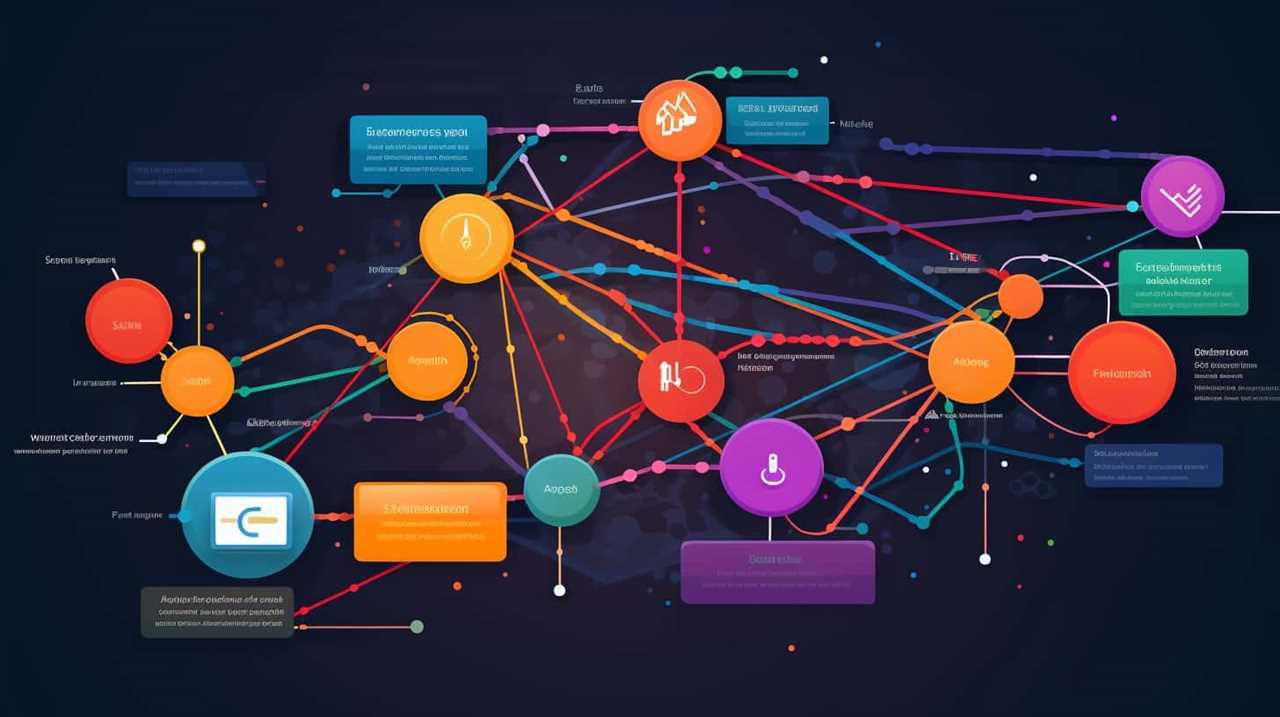As the proprietor of a standalone gaming shop, I’m well aware of the challenges involved in distinguishing ourselves within the densely populated online marketplace. Thus, it was exciting to learn that Google Ads could significantly enhance our online marketing approaches.
Did you know that businesses make an average of $2 for every $1 they spend on Google Ads? In this article, I’ll share the strategies I’ve learned for crafting compelling ad copy, targeting the right audience, and expanding my reach using the Google Display Network.
Get ready to take your online marketing to the next level.
Key Takeaways
- Google Ads is a powerful tool that can result in a high return on investment for independent game stores.
- Understanding the target audience’s demographics, interests, and behaviors is crucial for effective marketing.
- Setting clear goals, allocating the advertising budget wisely, and monitoring campaign performance are essential for success.
- Using long tail keywords, negative keywords, and the Google Display Network can help expand reach and target the right audience.
The Power of Google Ads
One powerful tool for independent game stores is the use of Google Ads. As a small business owner, you’re constantly seeking ways to maximize your return on investment (ROI) and reach your target audience effectively. Google Ads offers numerous benefits for small businesses like yours, helping you level up your online marketing game.

First and foremost, Google Ads allows you to reach a vast audience of potential customers who are actively searching for products or services related to your game store. By targeting specific keywords and demographics, you can ensure that your ads are seen by the right people at the right time. This targeted approach not only increases the chances of conversions but also helps you optimize your ad spend, getting the most out of your marketing budget.
Moreover, Google Ads provides you with valuable insights and analytics to measure the success of your campaigns. You can track metrics such as click-through rates, conversions, and cost per acquisition, allowing you to make data-driven decisions and constantly improve your advertising strategies. This level of precision and control is essential for businesses that desire mastery over their marketing efforts.
Understanding Your Target Audience
Understanding your target audience is crucial for effective online marketing. By understanding customer preferences and implementing segmentation strategies, you can tailor your marketing efforts to reach the right people with the right message at the right time. This will not only increase the effectiveness of your campaigns but also enhance customer satisfaction and drive sales.
To better understand your target audience, it’s important to gather and analyze data about their demographics, interests, and behaviors. This will help you create customer profiles or personas that represent your ideal customers. These personas can then be used to inform your marketing strategies, messaging, and targeting.

To illustrate the importance of understanding your target audience, consider the following table:
| Persona | Demographics | Interests | Behaviors | Pain Points |
|---|---|---|---|---|
| Gamer A | Male, 25-34 | RPGs, eSports | Plays games for several hours a day | Difficulty finding new game releases |
| Gamer B | Female, 18-24 | Puzzle games, Mobile gaming | Plays games on-the-go during commute | Lack of challenging puzzles in mobile games |
| Gamer C | Male, 35-44 | Strategy games, Online multiplayer | Prefers competitive gameplay | Limited time to invest in lengthy gaming sessions |
Setting Up Your Google Ads Account
Now that I’ve gained a deeper understanding of my target audience, I frequently set up my Google Ads account to maximize the effectiveness of my online marketing efforts. Setting up my Google Ads account involves several crucial steps that help me reach the right audience and achieve my advertising goals. Here’s how I do it:
- Understanding ad targeting: I carefully research and analyze the demographics, interests, and online behavior of my target audience. This helps me create targeted ads that resonate with them and increase the chances of conversion.
- Setting ad campaign goals: Before launching any campaign, I define clear goals such as increasing website traffic, boosting sales, or raising brand awareness. Having well-defined goals allows me to measure the success of my campaigns and make necessary adjustments.
- Budget allocation: I allocate my advertising budget wisely, focusing on channels and campaigns that have the highest potential for reaching my target audience. This ensures that I get the most out of my investment and achieve my desired results.
- Ad creation and optimization: I create compelling and visually appealing ads that grab the attention of my audience. I constantly monitor the performance of my ads and make necessary optimizations to improve their effectiveness.
- Tracking and analysis: I use Google Ads’ tracking tools to monitor the performance of my campaigns in real-time. This helps me identify what’s working and what’s not, allowing me to make data-driven decisions and improve the ROI of my advertising efforts.
Choosing the Right Keywords
After setting up my Google Ads account, the next step in maximizing the effectiveness of my online marketing efforts is choosing the right keywords. Keywords are the foundation of any successful campaign as they determine when and where your ads will appear. To ensure that my ads reach the right audience, I need to focus on two key strategies: long tail keywords and negative keywords.
Long tail keywords are specific phrases that are highly relevant to my game store. By using long tail keywords, I can maximize my visibility to potential customers who are actively searching for the products I offer. For example, instead of using a broad term like ‘video games,’ I can target a long tail keyword like ‘retro video game store in [city],’ which will help me reach customers looking specifically for retro games in their area.

On the other hand, negative keywords are equally important in filtering out irrelevant traffic. By specifying negative keywords, I can prevent my ads from showing up in searches that aren’t relevant to my business. For instance, if I sell physical copies of games, I might want to use ‘digital’ as a negative keyword to avoid attracting customers looking for digital downloads.
Crafting Compelling Ad Copy
Crafting compelling ad copy is essential for capturing the attention of potential customers and driving them to take action.
Effective ad messaging is all about delivering a clear and persuasive message that appeals to your target audience, highlighting the unique features and benefits of your game store.
Additionally, optimizing your call-to-action is crucial in guiding users towards the desired action, whether it’s making a purchase, signing up for a newsletter, or visiting your store.

Effective Ad Messaging
To maximize the impact of Google Ads, I focus on creating ad copy that engages and compels potential customers. Ad messaging optimization is crucial in capturing the attention of specific demographics.
Here are five key elements that I incorporate into my ad copy to evoke an emotional response in the audience:
- Persuasive language that resonates with the target audience
- Compelling storytelling that captures the imagination
- Use of social proof to establish credibility
- Attention-grabbing headlines that pique curiosity
- Clear and concise messaging that highlights unique selling points
By incorporating these elements, I ensure that my ads not only attract attention but also drive action.
Now, let’s dive into the next section: call-to-action optimization, where I’ll share strategies to maximize conversions and encourage potential customers to take the desired action.

Call-To-Action Optimization
For optimal results in Google Ads, I focus on optimizing the call-to-action in my ad copy. A well-crafted call-to-action can greatly improve user engagement and conversion rates. It is important to create a sense of urgency and compel the user to take action.
To achieve this, I make sure to use strong, action-oriented language in my ad copy. Words like "buy now," "shop today," or "learn more" can encourage users to click on the ad and explore further. Additionally, I leverage the power of emotional appeal by incorporating words that evoke excitement or curiosity.
Here is an example of how I optimize my call-to-action in my ad copy:
| Call-to-Action | Description |
|---|---|
| "Limited Time Offer" | Creates a sense of urgency and encourages immediate action |
| "Unlock Exclusive Content" | Appeals to users’ desire for unique and special experiences |
| "Get Started Now" | Indicates that taking action is easy and can be done immediately |
| "Join Our Community" | Invites users to become part of a larger gaming community |
Designing Effective Landing Pages
When it comes to designing effective landing pages, there are a few key points that can’t be overlooked.

First and foremost, visual appeal plays a crucial role in capturing the attention of visitors and increasing conversions.
A well-designed landing page should also have a clear call-to-action (CTA) that guides users towards taking the desired action, whether it’s making a purchase or signing up for a newsletter.
Additionally, in today’s mobile-driven world, it’s essential to ensure that your landing page is mobile-friendly to provide a seamless user experience across all devices.
Visual Appeal and Conversions
One key factor in increasing conversions on landing pages is utilizing visually appealing designs. When a landing page is visually appealing, it captures the attention of the user and encourages them to stay on the page longer. Here are five reasons why visually appealing designs can improve user experience and boost conversions:

- First impressions matter: A visually appealing design creates a positive first impression, making users more likely to trust and engage with your content.
- Easy navigation: A well-designed landing page makes it easy for users to find the information they need, improving user experience and encouraging conversions.
- Highlight key information: Visual elements such as images and infographics can effectively highlight key information and make it more memorable for users.
- Build credibility: A visually appealing design shows that you care about your brand and your customers, building trust and credibility.
- Stand out from the competition: In a crowded online marketplace, a visually appealing design sets you apart from the competition and attracts more attention from potential customers.
Clear Call-To-Action (Cta)
How can I design an effective landing page with a clear call-to-action (CTA)? Maximizing conversions relies heavily on the placement and design of your CTA. To ensure your CTA stands out and compels visitors to take action, consider these key elements:
| Element | Description |
|---|---|
| Clear and concise language | Use simple and direct language to clearly communicate what you want visitors to do. |
| Eye-catching design | Make your CTA visually appealing with contrasting colors, bold fonts, and strategic placement. |
| Placement above the fold | Position your CTA where it is immediately visible without the need to scroll down the page. |
| Compelling copy | Craft persuasive copy that highlights the benefits of taking action and creates a sense of urgency. |
Mobile-Friendly Design
Designing mobile-friendly landing pages is crucial for effective online marketing for independent game stores. With the increasing dominance of mobile devices, it’s essential to optimize the user experience on smaller screens.
Here are five reasons why responsive website design and user experience optimization should be a priority:
- Improved visibility: Mobile-friendly pages rank higher on search engine results, increasing the chances of attracting more visitors.
- Enhanced user engagement: A seamless mobile experience encourages users to stay longer on your website, explore your offerings, and potentially make a purchase.
- Higher conversion rates: Mobile-friendly design eliminates barriers and friction, leading to higher conversion rates and increased revenue.
- Competitive advantage: By offering a mobile-friendly experience, you can differentiate yourself from competitors and position your game store as modern and customer-oriented.
- Better brand perception: A well-designed mobile experience enhances your brand image, leading to increased trust and loyalty from customers.
Incorporating responsive website design and optimizing the user experience on mobile devices will undoubtedly level up your online marketing efforts for your independent game store.

Optimizing Your Ad Campaigns
To maximize the effectiveness of your ad campaigns, it’s crucial to constantly analyze and refine your strategies. Ad campaign targeting and optimization are key components of a successful online marketing campaign. By targeting the right audience, you can ensure that your ads are reaching the people who are most likely to be interested in your products or services. This not only saves you money by reducing wasted ad spend but also increases the chances of converting those viewers into customers.
One way to optimize your ad campaigns is by using Google Ads’ targeting tools. These tools allow you to narrow down your audience based on factors such as location, demographics, and interests. By understanding who your target audience is and tailoring your ads to their specific needs and preferences, you can significantly improve your campaign’s performance.
Another important aspect of ad campaign optimization is monitoring and analyzing your campaign’s performance metrics. This includes tracking key metrics such as click-through rates, conversion rates, and return on ad spend. By regularly reviewing these metrics, you can identify areas where your campaign is falling short and make necessary adjustments to improve its effectiveness.
Tracking and Analyzing Performance
When it comes to running successful online marketing campaigns, data-driven strategies are key. By tracking and analyzing the performance of your Google Ads, you can gain valuable insights into what’s working and what needs improvement. This allows you to make informed decisions and optimize your campaigns for better results.

Additionally, focusing on conversion rate optimization can help you maximize the impact of your ads and increase the number of customers who take action.
Data-Driven Marketing Strategies
How can I effectively track and analyze the performance of my marketing strategies using data-driven methods? This is a crucial question for anyone looking to optimize their online marketing efforts. By harnessing the power of data, you can make informed decisions that will drive success for your business.
Here are five key strategies to consider:
- Implementing tracking tools: Utilize tools like Google Analytics to gather data on website traffic, conversions, and user behavior.
- Setting clear goals: Define specific, measurable objectives for your marketing campaigns to track progress and determine success.
- Monitoring key metrics: Keep a close eye on metrics such as click-through rates, conversion rates, and customer acquisition costs to gauge campaign performance.
- A/B testing: Experiment with different variations of your marketing strategies to identify what resonates best with your audience.
- Regular analysis and optimization: Continuously analyze data, identify trends, and make data-driven adjustments to improve your marketing efforts.
Conversion Rate Optimization
As an independent game store owner, tracking and analyzing the performance of my marketing strategies is crucial, especially when it comes to conversion rate optimization. To ensure that my website is effectively converting visitors into customers, I focus on improving website navigation and utilizing customer journey mapping.

Improving website navigation is key to increasing conversion rates. By making it easy for customers to find what they’re looking for, I can streamline their experience and minimize frustration. This includes optimizing menus, search functionality, and overall site structure.
Customer journey mapping allows me to understand the path customers take from initial contact to making a purchase. By visualizing this journey, I can identify areas where customers may drop off or encounter obstacles. This insight helps me make targeted improvements to optimize conversions.
Budgeting and Bidding Strategies
In the article titled ‘Google Ads for Independent Game Stores: Leveling Up Online Marketing’, I’ll discuss the budgeting and bidding strategies. When it comes to running successful Google Ads campaigns, budget optimization and ad targeting are crucial factors.
Here are some important points to consider:

- Set a realistic budget: Determine how much you’re willing to invest in your Google Ads campaign and allocate your budget accordingly. This will ensure that you’re maximizing your ad spend while staying within your financial constraints.
- Monitor and adjust: Keep a close eye on your campaign’s performance and make adjustments as needed. Analyze the data and identify which keywords and ads are generating the most conversions. This will help you optimize your budget by focusing on what works best for your business.
- Use ad scheduling: Take advantage of Google Ads’ ad scheduling feature to control when your ads are shown. By targeting specific days and times, you can ensure that your budget is being utilized during peak periods when your target audience is most likely to be online.
- Bid strategically: Experiment with different bidding strategies to find the one that works best for your goals. Whether it’s manual bidding or automated bidding, understanding how to effectively bid on keywords can help you maximize your budget and achieve better results.
- Refine your targeting: Make use of Google Ads’ targeting options to reach your desired audience. Whether it’s by demographics, interests, or location, narrowing down your target audience will ensure that your budget is being spent on the most relevant potential customers.
A/B Testing for Success
To ensure the success of my Google Ads campaign for my independent game store, I’ll implement A/B testing strategies to optimize my ad performance. A/B testing, also known as split testing, allows me to compare two different versions of an ad to determine which one performs better. By testing different elements such as headlines, images, or call-to-action buttons, I can gather valuable insights and make data-driven decisions to improve my campaign effectiveness.
In order to conduct A/B testing effectively, I’ll follow some key techniques:
- Define clear objectives: Before starting the test, I’ll clearly define what I want to achieve. Whether it’s increasing click-through rates or maximizing conversions, having a specific goal in mind will help me measure the success of my campaign.
- Test one element at a time: To accurately measure the impact of each change, I’ll only test one element at a time. This way, I can attribute any improvements or declines in performance to that specific change.
- Split traffic evenly: It’s important to divide the traffic evenly between the two versions of the ad to ensure a fair comparison. This can be done by using A/B testing tools provided by Google Ads or manually splitting the traffic.
Remarketing to Previous Visitors
Implementing remarketing strategies allows me to target previous visitors and maximize the effectiveness of my Google Ads campaign for my independent game store. By utilizing conversion tracking, I can measure the effectiveness of my remarketing campaigns and make data-driven decisions to optimize my advertising efforts.
Additionally, dynamic remarketing enables me to personalize ads based on users’ previous interactions with my website, creating a more tailored and engaging experience for potential customers.

Here are five reasons why remarketing to previous visitors is crucial for my game store:
- Increased brand awareness: By repeatedly showing ads to previous visitors, I can reinforce my brand in their minds and increase the likelihood of them choosing my store for their gaming needs.
- Higher conversion rates: Remarketing allows me to target users who’ve already shown interest in my products, increasing the chances of them making a purchase and boosting my conversion rates.
- Cost-effective advertising: Since remarketing focuses on a specific audience, it minimizes wasteful spending on irrelevant clicks and impressions, making my advertising budget go further.
- Personalized messaging: Dynamic remarketing enables me to show ads that are tailored to users’ specific interests and preferences, increasing the relevance of my ads and driving higher engagement.
- Repeat business: By staying top of mind with previous visitors, remarketing encourages repeat business and builds customer loyalty, leading to long-term success for my game store.
Expanding Your Reach With Google Display Network
By utilizing the Google Display Network, I can expand my reach and further engage potential customers who’ve previously shown interest in my independent game store. The Google Display Network is a powerful tool that allows me to reach a wider audience by displaying my ads on a network of over two million websites and apps. This means that my ads can be seen by users who are browsing websites related to gaming, entertainment, and technology – all of which are relevant to my target audience.
One of the key benefits of using the Google Display Network is the ability to improve ad targeting. With this network, I can target my ads based on specific demographics, interests, and behaviors. This ensures that my ads are shown to the right people at the right time, increasing the chances of engagement and conversion.
In addition to expanding my reach, the Google Display Network also provides valuable insights for measuring campaign success. Through the network’s reporting and analytics tools, I can track key metrics such as impressions, clicks, and conversions. This data allows me to evaluate the effectiveness of my ads and make informed decisions to optimize my campaigns.

Frequently Asked Questions
How Much Does It Cost to Set up a Google Ads Account?
Setting up a Google Ads account involves cost considerations. However, there are alternatives to Google Ads that may be more budget-friendly. It’s important to weigh the pros and cons of each option before making a decision.
Are There Any Restrictions on the Types of Keywords That Can Be Used in Google Ads?
There are restrictions on the types of keywords that can be used in Google Ads. The keyword match types include Broad, Phrase, Exact, and Negative. Long tail keywords can have a significant impact on your campaigns.
Can I Track the Performance of My Google Ads Campaign in Real-Time?
Yes, I can track the performance of my Google Ads campaign in real-time. By tracking conversions and optimizing ad performance, I can make data-driven decisions to improve my online marketing strategy.
How Can I Determine the Right Budget for My Google Ads Campaign?
Determining the right budget for a Google Ads campaign is crucial for optimizing ROI. By analyzing historical data, setting clear goals, and testing different budget levels, I can make informed decisions to maximize results.

Is It Possible to Target Specific Geographical Locations With Google Ads?
Yes, you can target specific geographical locations with Google Ads. It’s an effective strategy to reach your desired audience and measure the effectiveness of your ads in different regions.
Conclusion
In conclusion, utilizing Google Ads is a game-changer for independent game stores looking to level up their online marketing. By understanding your target audience, setting up your account, choosing the right keywords, crafting compelling ad copy, and implementing budgeting and bidding strategies, you can reach a wider audience and drive more traffic to your store.
While some may argue that Google Ads can be costly, the potential return on investment and increased visibility far outweigh any initial expenses.
It’s time to take your game store to the next level with Google Ads.











